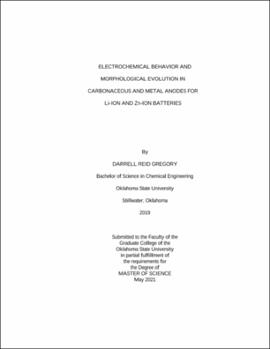| dc.contributor.advisor | Capraz, Omer Ozgur | |
| dc.contributor.author | Gregory, Darrell Reid | |
| dc.date.accessioned | 2021-09-24T13:57:58Z | |
| dc.date.available | 2021-09-24T13:57:58Z | |
| dc.date.issued | 2021-05 | |
| dc.identifier.uri | https://hdl.handle.net/11244/330911 | |
| dc.description.abstract | Li-ion batteries are ubiquitous in modern society with widespread applications in electric vehicles, personal electronics, and renewable energy storage. However, the practical energy density of the graphite anode commonly used in commercially available Li-ion batteries is approaching its theoretical limits. One potential solution to overcome this limitation is to replace graphite anodes with metallic anodes which have much higher theoretical charge storage capacities (3860, 1165, 860 mAh/g for Li, Na, Zn metal anodes respectively vs. 372 mAh/g for graphite). Unfortunately, problems arise during charging of metal anodes when metal ions are plated onto the electrode. These ions tend to deposit unevenly over the surface producing rough morphologies called dendrites which can grow through the separator and contact the counter electrode causing a short circuit, thermal runaway, and potential ignition of the flammable electrolyte and explosion. | |
| dc.description.abstract | My master's project investigated how electrode surface layers impact dendrite growth on Zn metal electrodes. Zn metal provides the opportunity to elucidate the effect of organic surface layers on metal deposition since Zn is stable in both organic and aqueous electrolytes. Symmetric cells were assembled using Li, Na, or Zn metal in an analogous organic electrolyte (1 M M(ClO4)x in EC:DMC where M is Li, Na, or Zn) and compared to a Zn cell with aqueous electrolyte (1 M Zn(ClO4)2). Further investigations were done to determine the surface layer effects by forming an organic surface layer on Zn metal electrodes and cycling them in aqueous electrolyte and comparing this to the performance of Zn metal anodes with an inorganic layer cycled in organic electrolytes. | |
| dc.description.abstract | My master's studies included another project about utilization of industrial waste as potential Li-ion battery electrodes. The effectiveness of collected diesel engine exhaust soot as a potential anode material for Li-ion batteries was evaluated through a series of electrochemical characterization tests including rate performance testing, long-term cycling stability, and charge storage kinetics analysis. Material properties were determined using XRD, XPS, and Raman spectroscopy. The annealed soot electrodes displayed excellent rate capability and capacity retention along with a pseudocapacitive contribution to charge storage making them an inexpensive alternative to the graphite anode. | |
| dc.format | application/pdf | |
| dc.language | en_US | |
| dc.rights | Copyright is held by the author who has granted the Oklahoma State University Library the non-exclusive right to share this material in its institutional repository. Contact Digital Library Services at lib-dls@okstate.edu or 405-744-9161 for the permission policy on the use, reproduction or distribution of this material. | |
| dc.title | Electrochemical behavior and morphological evolution in carbonaceous and metal anodes for Li-ion and Zn-ion batteries | |
| dc.contributor.committeeMember | Shah, Jindal | |
| dc.contributor.committeeMember | Andiappan, Marimuthu | |
| dc.contributor.committeeMember | Sachan, Ritesh | |
| osu.filename | Gregory_okstate_0664M_17150.pdf | |
| osu.accesstype | Open Access | |
| dc.type.genre | Thesis | |
| dc.type.material | Text | |
| dc.subject.keywords | battery | |
| dc.subject.keywords | dendrite | |
| dc.subject.keywords | metal electrodes | |
| dc.subject.keywords | particulate matter | |
| dc.subject.keywords | pseudocapacitance | |
| dc.subject.keywords | solid-electrolyte interface | |
| thesis.degree.discipline | Chemical Engineering | |
| thesis.degree.grantor | Oklahoma State University | |
